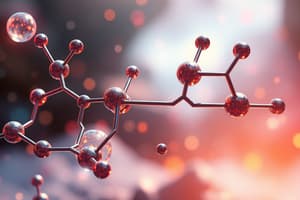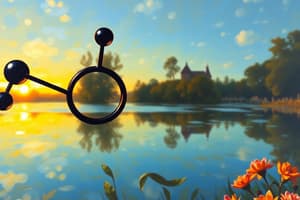Podcast
Questions and Answers
Which of the following is NOT a type of organic molecule?
Which of the following is NOT a type of organic molecule?
- Aromatics
- Halides (correct)
- Alkanes
- Alkenes
Which of the following functional groups is found in carboxylic acids?
Which of the following functional groups is found in carboxylic acids?
- Carbonyl group
- Hydroxyl group (correct)
- Phosphate group
- Amino group
Which biological macromolecule is responsible for our genetic structure?
Which biological macromolecule is responsible for our genetic structure?
- Lipids
- Carbohydrates
- Proteins
- Nucleic acids (correct)
Which of the following is a characteristic of alcohols?
Which of the following is a characteristic of alcohols?
Which of the following is a characteristic of lipids?
Which of the following is a characteristic of lipids?
Which of the following is a characteristic of proteins?
Which of the following is a characteristic of proteins?
Study Notes
Overview of Organic Molecules: Hydrocarbons, Alcohols, Carboxylic Acids, and Macromolecules
- Organic molecules contain carbon combined with other elements and include four groups: alkanes, alkenes, alkynes, and aromatics.
- Alcohols contain a hydroxyl group, which comprises an oxygen with a single bond to a hydrogen and another single bond to an alkane-type carbon.
- Carboxylic acids contain a carboxylic acid group, which comprises a hydroxyl group connected to a carbonyl group.
- Butyl Acetate is a colorless liquid used in photographic film, lacquers, perfumes, oils, and resins.
- Biological macromolecules include carbohydrates, lipids, proteins, and nucleic acids, which are hydrocarbons that may include oxygen, nitrogen, phosphorus, and sulfur.
- Carbohydrates are the body's main source of energy, while lipids provide stored energy reserves.
- Proteins help us stay strong by forming new bones and muscles and helping us fight diseases.
- Nucleic acids are responsible for making each person functional and unique; they are the blueprint for our genetic structure.
- Carbohydrates are placed into one of three categories, depending on the number of monosaccharide units or residues they contain: monosaccharides, oligosaccharides, and polysaccharides.
- Monosaccharides are carbohydrate molecules that cannot be broken down by hydrolysis into simpler (smaller) carbohydrate molecules.
- Lipids are organic substances found in living systems that are insoluble in water but soluble in organic solvents.
- Proteins are complex substances that consist of amino acid residues joined by peptide bonds and include many essential biological compounds such as enzymes, hormones, and antibodies.
Overview of Organic Molecules: Hydrocarbons, Alcohols, Carboxylic Acids, and Macromolecules
- Organic molecules contain carbon combined with other elements and include four groups: alkanes, alkenes, alkynes, and aromatics.
- Alcohols contain a hydroxyl group, which comprises an oxygen with a single bond to a hydrogen and another single bond to an alkane-type carbon.
- Carboxylic acids contain a carboxylic acid group, which comprises a hydroxyl group connected to a carbonyl group.
- Butyl Acetate is a colorless liquid used in photographic film, lacquers, perfumes, oils, and resins.
- Biological macromolecules include carbohydrates, lipids, proteins, and nucleic acids, which are hydrocarbons that may include oxygen, nitrogen, phosphorus, and sulfur.
- Carbohydrates are the body's main source of energy, while lipids provide stored energy reserves.
- Proteins help us stay strong by forming new bones and muscles and helping us fight diseases.
- Nucleic acids are responsible for making each person functional and unique; they are the blueprint for our genetic structure.
- Carbohydrates are placed into one of three categories, depending on the number of monosaccharide units or residues they contain: monosaccharides, oligosaccharides, and polysaccharides.
- Monosaccharides are carbohydrate molecules that cannot be broken down by hydrolysis into simpler (smaller) carbohydrate molecules.
- Lipids are organic substances found in living systems that are insoluble in water but soluble in organic solvents.
- Proteins are complex substances that consist of amino acid residues joined by peptide bonds and include many essential biological compounds such as enzymes, hormones, and antibodies.
Studying That Suits You
Use AI to generate personalized quizzes and flashcards to suit your learning preferences.
Description
Test your knowledge on organic molecules and biological macromolecules with this comprehensive quiz! From hydrocarbons to carboxylic acids and macromolecules like carbohydrates, lipids, proteins, and nucleic acids, this quiz covers it all. See how well you understand the structures and functions of these important molecules in our bodies and the world around us. Challenge yourself and learn something new with this overview of organic molecules and macromolecules quiz.




